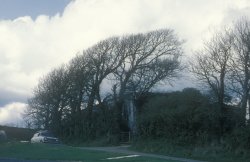Dutch elm disease is one of the most serious tree diseases in the world. Bark beetles spread the fungus that causes the disease, which triggers foliage and tip dieback in all of Britain’s major native elms: English elm (Ulmus procera), smooth-leaved elm (U. carpinifolia or U. minor) and wych elm (U. glabra).
The disease first spread to Britain in the 1920s, when it killed 10-40% of elm trees. Although the initial epidemic died down, a more aggressive species of the Dutch elm disease fungus, Ophiostoma novo-ulmi, was accidentally introduced into Britain in the 1960s.
The epidemic rapidly took hold of lowland central and southern Britain in the 1970s. However the rate of disease progress was markedly slower in the smooth-leaved elm populations of East Anglia and the Cornish elm (U. carpinifolia var. cornubiensis) populations of the south-west peninsula. Despite this, the majority of mature Cornish elm and East Anglian smooth-leaved elms have now been killed by the disease.

Pictured is a typical Cornish elm hedgerow killed by Dutch elm disease.